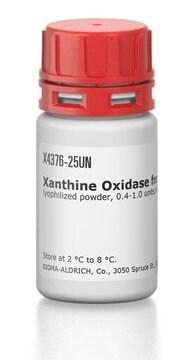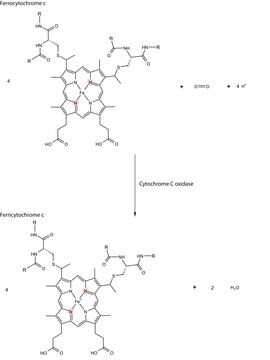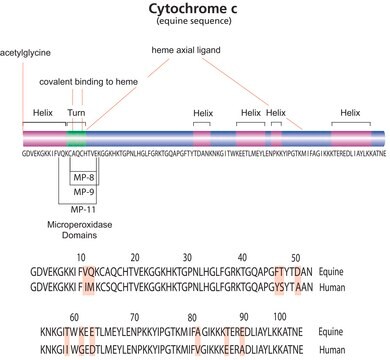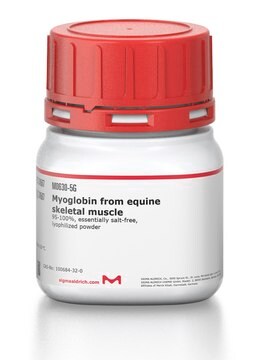C6749
Cytochrome c equine
recombinant, expressed in E. coli
Iniciar sesiónpara Ver la Fijación de precios por contrato y de la organización
About This Item
Productos recomendados
biological source
horse
Quality Level
recombinant
expressed in E. coli
assay
≥95% (SDS-PAGE)
form
powder
UniProt accession no.
storage temp.
−20°C
Gene Information
horse ... CYCS(100053958)
Application
Cytochrome c polymerization occurs by successive domain swapping, which may be a common mechanism of protein polymerization. Cytochrome c has been used in a study to establish that an optimized pulsed-Q dissociation and collision-activated dissociation hybrid workflow may have wide applications in biological and biomedical research.
Biochem/physiol Actions
Cytochrome c has been identified as an important mediator in apoptotic pathways. The release of mitochondrial cytochrome c into the cytoplasm stimulates apoptosis and is commonly used as an indicator of the apoptotic process in the cell.
Cytochrome c is primarily known as an electron-carrying mitochondrial protein. The transition of cytochrome c between the ferrous and ferric states within the cell makes it an efficient biological electron-transporter and it plays a vital role in cellular oxidations in both plants and animals. It is generally regarded as a universal catalyst of respiration, forming an essential electron-bridge between the respirable substrates and oxygen
Preparation Note
Produced using animal component-free materials.
Other Notes
View more information on cytochrome c and electron transport at www.sigma-aldrich.com/enzymeexplorer.
Storage Class
11 - Combustible Solids
wgk_germany
WGK 3
flash_point_f
Not applicable
flash_point_c
Not applicable
Certificados de análisis (COA)
Busque Certificados de análisis (COA) introduciendo el número de lote del producto. Los números de lote se encuentran en la etiqueta del producto después de las palabras «Lot» o «Batch»
¿Ya tiene este producto?
Encuentre la documentación para los productos que ha comprado recientemente en la Biblioteca de documentos.
Los clientes también vieron
Ramil F Latypov et al.
Journal of molecular biology, 383(2), 437-453 (2008-09-02)
Despite close structural similarity, the ferric and ferrous forms of cytochrome c differ greatly in terms of their ligand binding properties, stability, folding, and dynamics. The reduced heme iron binds diatomic ligands such as CO only under destabilizing conditions that
Ying Dong et al.
Clinical cancer research : an official journal of the American Association for Cancer Research, 15(1), 131-139 (2009-01-02)
beta-Lapachone (ARQ 501, a formulation of beta-lapachone complexed with hydroxypropyl-beta-cyclodextrin) is a novel anticancer agent with selectivity against prostate cancer cells overexpressing the NAD(P)H:quinone oxidoreductase-1 enzyme. Lack of solubility and an efficient drug delivery strategy limits this compound in clinical
Tiannan Guo et al.
Journal of proteome research, 7(11), 4831-4840 (2008-10-08)
Coupling of multiplex isobaric tags for relative and absolute quantitation (iTRAQ) to a sensitive linear ion trap (LTQ) mass spectrometer (MS) is a challenging, but highly promising approach for quantitative high-throughput proteomic profiling. Integration of the advantages of pulsed-Q dissociation
Shun Hirota et al.
Proceedings of the National Academy of Sciences of the United States of America, 107(29), 12854-12859 (2010-07-10)
Cytochrome c (cyt c) is a stable protein that functions in a monomeric state as an electron donor for cytochrome c oxidase. It is also released to the cytosol when permeabilization of the mitochondrial outer membrane occurs at the early
Dorival Martins et al.
Frontiers in microbiology, 11, 576708-576708 (2020-10-27)
Stressors and environmental cues shape the physiological state of bacteria, and thus how they subsequently respond to antibiotic toxicity. To understand how superoxide stress can modulate survival to bactericidal antibiotics, we examined the effect of intracellular superoxide generators, paraquat and
Protocolos
Separation of HPLC protein standard mixture, analytical standard
Nuestro equipo de científicos tiene experiencia en todas las áreas de investigación: Ciencias de la vida, Ciencia de los materiales, Síntesis química, Cromatografía, Analítica y muchas otras.
Póngase en contacto con el Servicio técnico






